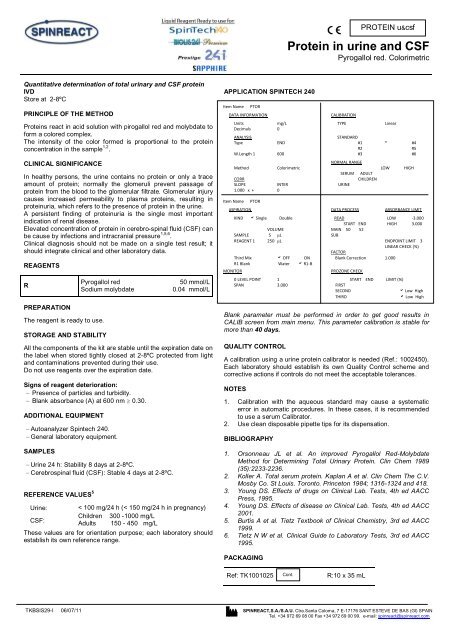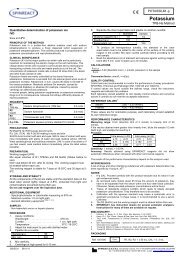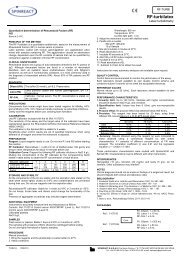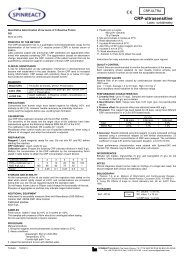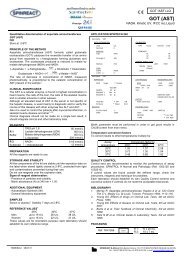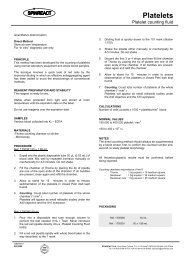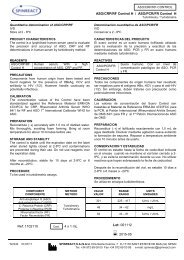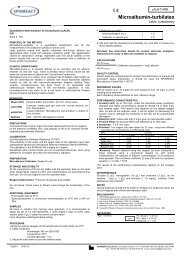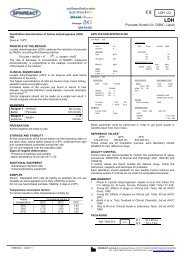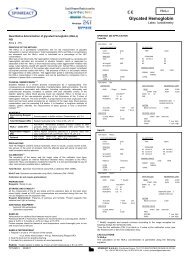Protein in urine and CSF
Protein in urine and CSF - Spinreact
Protein in urine and CSF - Spinreact
- No tags were found...
Create successful ePaper yourself
Turn your PDF publications into a flip-book with our unique Google optimized e-Paper software.
PROTEIN u&csf<br />
<strong>Prote<strong>in</strong></strong> <strong>in</strong> ur<strong>in</strong>e <strong>and</strong> <strong>CSF</strong><br />
Pyrogallol red. Colorimetric<br />
Quantitative determ<strong>in</strong>ation of total ur<strong>in</strong>ary <strong>and</strong> <strong>CSF</strong> prote<strong>in</strong><br />
IVD<br />
Store at 2-8ºC<br />
PRINCIPLE OF THE METHOD<br />
<strong>Prote<strong>in</strong></strong>s react <strong>in</strong> acid solution with pirogallol red <strong>and</strong> molybdate to<br />
form a colored complex.<br />
The <strong>in</strong>tensity of the color formed is proportional to the prote<strong>in</strong><br />
concentration <strong>in</strong> the sample 1,2 .<br />
CLINICAL SIGNIFICANCE<br />
In healthy persons, the ur<strong>in</strong>e conta<strong>in</strong>s no prote<strong>in</strong> or only a trace<br />
amount of prote<strong>in</strong>; normally the glomeruli prevent passage of<br />
prote<strong>in</strong> from the blood to the glomerular filtrate. Glomerular <strong>in</strong>jury<br />
causes <strong>in</strong>creased permeability to plasma prote<strong>in</strong>s, result<strong>in</strong>g <strong>in</strong><br />
prote<strong>in</strong>uria, which refers to the presence of prote<strong>in</strong> <strong>in</strong> the ur<strong>in</strong>e.<br />
A persistent f<strong>in</strong>d<strong>in</strong>g of prote<strong>in</strong>uria is the s<strong>in</strong>gle most important<br />
<strong>in</strong>dication of renal disease.<br />
Elevated concentration of prote<strong>in</strong> <strong>in</strong> cerebro-sp<strong>in</strong>al fluid (<strong>CSF</strong>) can<br />
be cause by <strong>in</strong>fections <strong>and</strong> <strong>in</strong>tracranial pressure 1,5,6 .<br />
Cl<strong>in</strong>ical diagnosis should not be made on a s<strong>in</strong>gle test result; it<br />
should <strong>in</strong>tegrate cl<strong>in</strong>ical <strong>and</strong> other laboratory data.<br />
REAGENTS<br />
R<br />
PREPARATION<br />
The reagent is ready to use.<br />
STORAGE AND STABILITY<br />
Pyrogallol red<br />
Sodium molybdate<br />
50 mmol/L<br />
0.04 mmol/L<br />
All the components of the kit are stable until the expiration date on<br />
the label when stored tightly closed at 2-8ºC protected from light<br />
<strong>and</strong> contam<strong>in</strong>ations prevented dur<strong>in</strong>g their use.<br />
Do not use reagents over the expiration date.<br />
Signs of reagent deterioration:<br />
Presence of particles <strong>and</strong> turbidity.<br />
Blank absorbance (A) at 600 nm 0.30.<br />
ADDITIONAL EQUIPMENT<br />
Autoanalyzer Sp<strong>in</strong>tech 240.<br />
General laboratory equipment.<br />
SAMPLES<br />
Ur<strong>in</strong>e 24 h: Stability 8 days at 2-8ºC.<br />
Cerebrosp<strong>in</strong>al fluid (<strong>CSF</strong>): Stable 4 days at 2-8ºC.<br />
REFERENCE VALUES 5<br />
Ur<strong>in</strong>e:<br />
<strong>CSF</strong>:<br />
< 100 mg/24 h (< 150 mg/24 h <strong>in</strong> pregnancy)<br />
Children 300 -1000 mg/L<br />
Adults 150 - 450 mg/L<br />
These values are for orientation purpose; each laboratory should<br />
establish its own reference range.<br />
APPLICATION SPINTECH 240<br />
Item Name<br />
Blank parameter must be performed <strong>in</strong> order to get good results <strong>in</strong><br />
CALIB screen from ma<strong>in</strong> menu. This parameter calibration is stable for<br />
more than 40 days.<br />
QUALITY CONTROL<br />
A calibration us<strong>in</strong>g a ur<strong>in</strong>e prote<strong>in</strong> calibrator is needed (Ref.: 1002450).<br />
Each laboratory should establish its own Quality Control scheme <strong>and</strong><br />
corrective actions if controls do not meet the acceptable tolerances.<br />
NOTES<br />
PTOR<br />
DATA INFORMATION<br />
1. Calibration with the aqueous st<strong>and</strong>ard may cause a systematic<br />
error <strong>in</strong> automatic procedures. In these cases, it is recommended<br />
to use a serum Calibrator.<br />
2. Use clean disposable pipette tips for its dispensation.<br />
BIBLIOGRAPHY<br />
CALIBRATION<br />
Units mg/L TYPE L<strong>in</strong>ear<br />
Decimals 0<br />
ANALYSIS<br />
STANDARD<br />
Type END #1 * #4<br />
#2 #5<br />
W.Length 1 600 #3 #6<br />
NORMAL RANGE<br />
Method Colorimetric LOW HIGH<br />
SERUM ADULT<br />
CORR<br />
CHILDREN<br />
SLOPE INTER URINE<br />
1.000 x + 0<br />
Item Name<br />
PTOR<br />
ASPIRATION DATA PROCESS ABSORBANCE LIMIT<br />
KIND S<strong>in</strong>gle Double READ LOW -3.000<br />
START END HIGH 3.000<br />
VOLUME MAIN 50 52<br />
SAMPLE 5 L SUB<br />
REAGENT 1 250 L ENDPOINT LIMIT 3<br />
LINEAR CHECK (%)<br />
FACTOR<br />
Third Mix OFF ON Blank Correction 1.000<br />
R1 Blank Water R1-B<br />
MONITOR<br />
PROZONE CHECK<br />
0 LEVEL POINT 1 START END LIMIT (%)<br />
SPAN 3.000 FIRST<br />
SECOND<br />
Low High<br />
THIRD<br />
Low High<br />
1. Orsonneau JL et al. An improved Pyrogallol Red-Molybdate<br />
Method for Determ<strong>in</strong><strong>in</strong>g Total Ur<strong>in</strong>ary <strong>Prote<strong>in</strong></strong>. Cl<strong>in</strong> Chem 1989<br />
(35):2233-2236.<br />
2. Koller A. Total serum prote<strong>in</strong>. Kaplan A et al. Cl<strong>in</strong> Chem The C.V.<br />
Mosby Co. St Louis. Toronto. Pr<strong>in</strong>ceton 1984; 1316-1324 <strong>and</strong> 418.<br />
3. Young DS. Effects of drugs on Cl<strong>in</strong>ical Lab. Tests, 4th ed AACC<br />
Press, 1995.<br />
4. Young DS. Effects of disease on Cl<strong>in</strong>ical Lab. Tests, 4th ed AACC<br />
2001.<br />
5. Burtis A et al. Tietz Textbook of Cl<strong>in</strong>ical Chemistry, 3rd ed AACC<br />
1999.<br />
6. Tietz N W et al. Cl<strong>in</strong>ical Guide to Laboratory Tests, 3rd ed AACC<br />
1995.<br />
PACKAGING<br />
Ref: TK1001025<br />
Cont.<br />
R:10 x 35 mL<br />
TKBSIS29-I 06/07/11 SPINREACT,S.A./S.A.U. Ctra.Santa Coloma, 7 E-17176 SANT ESTEVE DE BAS (GI) SPAIN<br />
Tel. +34 972 69 08 00 Fax +34 972 69 00 99. e-mail: sp<strong>in</strong>react@sp<strong>in</strong>react.com
PROTEIN u&csf<br />
Proteínas en or<strong>in</strong>a y LCR<br />
Rojo pirogalol. Colorimétrico<br />
Determ<strong>in</strong>ación cuantitativa de proteínas totales en or<strong>in</strong>a y<br />
LCR<br />
IVD<br />
Conservar a 2-8ºC<br />
PRINCIPIO DEL MÉTODO<br />
Las proteínas presentes en la muestra reaccionan en medio<br />
ácido con el rojo pirogalol y el molibdato, form<strong>and</strong>o un complejo<br />
coloreado.<br />
La <strong>in</strong>tensidad del color formado es proporcional a la<br />
concentración de proteínas en la muestra ensayada 1,2 .<br />
SIGNIFICADO CLÍNICO<br />
La or<strong>in</strong>a de personas sanas no contiene proteínas ó sólo<br />
pequeñas cantidades; normalmente el glomérulo evita el paso de<br />
estas de la sangre al filtrado glomerular.<br />
Alteraciones glomerulares causan el aumento de la<br />
permeabilidad de las proteínas plasmáticas lo que ocasiona la<br />
prote<strong>in</strong>úria, que <strong>in</strong>dica presencia de proteínas en or<strong>in</strong>a.<br />
La presencia persistente de prote<strong>in</strong>úria <strong>in</strong>dica enfermedad renal.<br />
Concentraciones elevadas de proteínas en líquido<br />
cefalorraquídeo (LCR) pueden ser debidas a <strong>in</strong>fecciones o a<br />
presión <strong>in</strong>tracraneal elevada 1,5,6, .<br />
El diagnostico clínico debe realizarse teniendo en cuenta todos<br />
los datos clínicos y de laboratorio.<br />
REACTIVOS<br />
R<br />
PREPARACIÓN<br />
Rojo pirogalol<br />
Molibdato sódico<br />
El reactivo está listo para su uso.<br />
CONSERVACIÓN Y ESTABILIDAD<br />
50 mmol/L<br />
0,04 mmol/L<br />
Todos los componentes del kit son estables, hasta la fecha de<br />
caducidad <strong>in</strong>dicada en la etiqueta, cu<strong>and</strong>o se mantienen los frascos<br />
bien cerrados a 2-8ºC, protegidos de la luz y se evita su<br />
contam<strong>in</strong>ación. No usar reactivos fuera de la fecha <strong>in</strong>dicada.<br />
Indicadores de deterioro de los reactivos:<br />
Presencia de partículas y turbidez.<br />
Absorbancia (A) del Blanco a 600 nm 0,30.<br />
MATERIAL ADICIONAL<br />
Autoanalizador Sp<strong>in</strong>tech 240.<br />
Equipamiento habitual de laboratorio.<br />
MUESTRAS<br />
Or<strong>in</strong>a de 24 h: Estable 8 días a 2-8ºC.<br />
Liquido cefalorraquídeo (LCR): Estable 4 días a 2-8ºC<br />
VALORES DE REFERENCIA 5<br />
Or<strong>in</strong>a: < 100 mg/24 h (en mujeres embarazadas < 150 mg/24 h)<br />
Niños 300 -1000 mg/L<br />
LCR:<br />
Adultos 150 - 450 mg/L<br />
Estos valores son orientativos. Es recomendable que cada<br />
laboratorio establezca sus propios valores de referencia.<br />
APLICACIÓN AL SPINTECH 240<br />
Item Name<br />
Es necesario solicitar el blanco en este parámetro para obtener<br />
resultados correctos en la pantalla pr<strong>in</strong>cipal de CALIB. La Calibración<br />
de este parámetro es estable más de 40 días.<br />
CONTROL DE CALIDAD<br />
Es conveniente calibrar utiliz<strong>and</strong>o el Calibrador de proteínas en Or<strong>in</strong>a<br />
(Ref.: 1002450). Cada laboratorio debe disponer su propio Control de<br />
Calidad y establecer correcciones en el caso de que los controles no<br />
cumplan con las tolerancias.<br />
NOTAS<br />
PTOR<br />
DATA INFORMATION<br />
1. La calibración con el Patrón acuoso puede dar lugar a errores<br />
sistemáticos en métodos automáticos. En este caso, se recomienda<br />
utilizar calibradores séricos.<br />
2. Usar puntas de pipeta desechables limpias para su dispensación.<br />
BIBLIOGRAFIA<br />
1. Orsonneau JL et al. An improved Pyrogallol Red-Molybdate<br />
Method for Determ<strong>in</strong><strong>in</strong>g Total Ur<strong>in</strong>ary <strong>Prote<strong>in</strong></strong>. Cl<strong>in</strong> Chem 1989;<br />
35:2233-2236.<br />
2. Koller A. Total serum prote<strong>in</strong>. Kaplan A et al. Cl<strong>in</strong> Chem The C.V.<br />
Mosby Co. St Louis. Toronto. Pr<strong>in</strong>ceton 1984; 1316-1324 <strong>and</strong> 418.<br />
3. Young DS. Effects of drugs on Cl<strong>in</strong>ical Lab. Tests, 4th ed AACC<br />
Press, 1995.<br />
4. Young DS. Effects of disease on Cl<strong>in</strong>ical Lab. Tests, 4th ed AACC<br />
2001.<br />
5. Burtis A et al. Tietz Textbook of Cl<strong>in</strong>ical Chemistry, 3rd ed AACC<br />
1999.<br />
6. Tietz N W et al. Cl<strong>in</strong>ical Guide to Laboratory Tests, 3rd ed AACC<br />
1995.<br />
PRESENTACION<br />
Ref: TK1001025<br />
Cont.<br />
CALIBRATION<br />
Units mg/L TYPE L<strong>in</strong>ear<br />
Decimals 0<br />
ANALYSIS<br />
STANDARD<br />
Type END #1 * #4<br />
#2 #5<br />
W.Length 1 600 #3 #6<br />
NORMAL RANGE<br />
Method Colorimetric LOW HIGH<br />
SERUM ADULT<br />
CORR<br />
CHILDREN<br />
SLOPE INTER URINE<br />
1.000 x + 0<br />
Item Name<br />
PTOR<br />
ASPIRATION DATA PROCESS ABSORBANCE LIMIT<br />
KIND S<strong>in</strong>gle Double READ LOW -3.000<br />
START END HIGH 3.000<br />
VOLUME MAIN 50 52<br />
SAMPLE 5 L SUB<br />
REAGENT 1 250 L ENDPOINT LIMIT 3<br />
LINEAR CHECK (%)<br />
FACTOR<br />
Third Mix OFF ON Blank Correction 1.000<br />
R1 Blank Water R1-B<br />
MONITOR<br />
PROZONE CHECK<br />
0 LEVEL POINT 1 START END LIMIT (%)<br />
SPAN 3.000 FIRST<br />
SECOND<br />
Low High<br />
THIRD<br />
Low High<br />
R:10 x 35 mL<br />
TKBSIS29-E 06/07/11 SPINREACT,S.A./S.A.U.Ctra.Santa Coloma, 7 E-17176 SANT ESTEVE DE BAS (GI) SPAIN<br />
Tel. +34 972 69 08 00 Fax +34 972 69 00 99. e-mail: sp<strong>in</strong>react@sp<strong>in</strong>react.com


